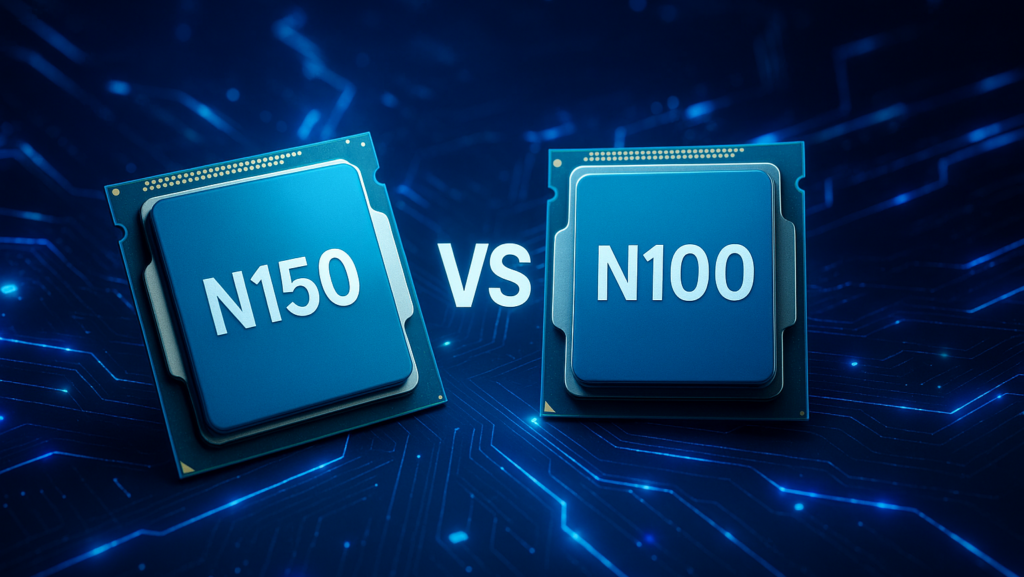Recently, Intel released the N150, a refresh of the N100 with slightly higher clock speeds and a newer core design. But how much better is the Intel N150 vs. N100 really—and is it worth the switch? Let’s compare the two CPUs and help you decide which is right for your DIY NAS project.
When building a budget-friendly DIY NAS, one of the very first questions is which CPU delivers sufficient performance while remaining power-efficient. Among the most attractive options on the market today is the Intel N100, a compact and energy-efficient chip that has quickly gained popularity in the NAS community. It strikes a rare balance between very low power consumption, solid performance, and modern features like DDR5 support and integrated graphics—making it an ideal foundation for home storage solutions.
With a low 6W TDP, the N100 enables quiet, fanless operation. Its ability to handle multiple light workloads makes it perfect for file sharing, automated backups, media streaming, and even lightweight container environments like Docker or Home Assistant. As a result, the N100 has become the go-to choice for budget NAS builders around the world.
Factsheet – Intel N150 vs. N100 at a Glance
| Feature | Intel N150 | Intel N100 |
|---|---|---|
| Architecture | Twin Lake (Alder Lake-N Refresh) | Alder Lake-N |
| Cores / Threads | 4 / 4 | 4 / 4 |
| Base Clock | 2.0 GHz | 1.8 GHz |
| Max Turbo Frequency | 3.6 GHz | 3.4 GHz |
| L3 Cache | 6 MB | 6 MB |
| TDP | 6 W | 6 W |
| Memory Support | DDR4, DDR5, LPDDR5 (official up to 16 GB) | DDR4, DDR5, LPDDR5 (official up to 16 GB, but we tested and verified by us with 32 GB) |
| Integrated Graphics | Intel UHD Graphics 730 | Intel UHD Graphics 730 |
| Release Date | November 2024 | January 2023 |
Benchmark Performance Insights Intel N150 vs. N100
The N150, with its newer architecture, offers a slightly higher turbo frequency of 3.6 GHz compared to the N100’s 3.4 GHz. Benchmark results show modest improvements:
Source: CPU-Monkey.com
While measurable, these performance differences are relatively minor and unlikely to impact typical NAS workloads like file storage, backups, or lightweight media streaming.
NAS Suitability: What Really Matters
Both processors are excellent choices for NAS applications. Here’s why:
- Low Power Consumption: With a TDP of only 6 W, both CPUs run cool and energy-efficient, ideal for 24/7 uptime.
- Modern Memory Support: Both support DDR4, DDR5, and LPDDR5 memory, offering flexibility and future-proofing.
- Integrated Graphics: Handy for media transcoding (e.g. Plex, Jellyfin, Frigate).
Both CPUs support DDR5 memory with on-die ECC, enhancing data integrity—an important feature for NAS builders concerned with reliability. While not true server-grade ECC, it adds a layer of error correction that’s better than nothing.
Availability and Cost
The Intel N100 has been widely available since its release in early 2023, leading to a healthy ecosystem of mini PCs and motherboards based on this chip. It’s generally more affordable than the newer N150, which is still relatively scarce in the DIY market as of 2025.
If you’re building a NAS on a budget, the N100 is usually easier to find and costs less—making it the better value overall
Conclusion: The Winner Is… N100
Although the Intel N150 offers slight improvements in raw performance, they don’t justify the higher price and reduced availability—at least not yet. For most DIY NAS users, the Intel N100 remains the best bang for the buck.
It delivers reliable performance, excellent power efficiency, and broad compatibility with low-cost, readily available hardware. This is the reason why we keep the N100 for our Budget NAS Build.
Budget NAS Build



